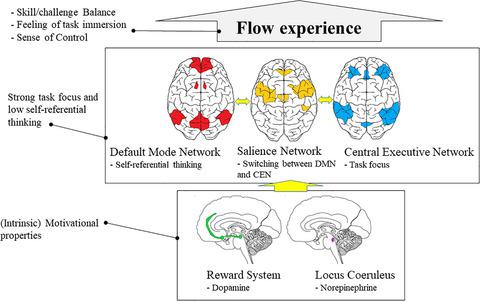当前位置:
X-MOL 学术
›
Eur. J. Neurosci.
›
论文详情
Our official English website, www.x-mol.net, welcomes your
feedback! (Note: you will need to create a separate account there.)
Go with the flow: A neuroscientific view on being fully engaged
European Journal of Neuroscience ( IF 2.7 ) Pub Date : 2020-10-21 , DOI: 10.1111/ejn.15014 Dimitri van der Linden 1 , Mattie Tops 2 , Arnold B Bakker 1, 3
European Journal of Neuroscience ( IF 2.7 ) Pub Date : 2020-10-21 , DOI: 10.1111/ejn.15014 Dimitri van der Linden 1 , Mattie Tops 2 , Arnold B Bakker 1, 3
Affiliation

|
Flow is a state of full task absorption, accompanied with a strong drive and low levels of self‐referential thinking. Flow is likely when there is a match between a person's skills and the task challenge. Despite its relevance for human performance and the vast body of research on flow, there is currently still relatively little insight in its underlying neurocognitive mechanisms. In this paper, we discuss a set of large brain networks that may be involved in establishing the core dimensions of flow. We propose that dopaminergic and noradrenergic systems mediate the intrinsic motivation and activate mood states that are typical for flow. The interaction between three large‐scale attentional networks, namely the Default Mode Network, Central Executive Network and the Salience Network is proposed to play a role in the strong task engagement, low self‐referential thinking, feedback and feelings of control in flow. The proposed relationships between flow and the brain networks may support the generation of new hypotheses and can guide future research in this field.
中文翻译:

随波逐流:关于全神贯注的神经科学观点
心流是一种全神贯注于任务的状态,伴随着强烈的驱动力和低水平的自我参照思维。当一个人的技能与任务挑战相匹配时,心流就有可能出现。尽管心流与人类表现相关并且有大量研究,但目前对其潜在的神经认知机制的了解仍然相对较少。在本文中,我们讨论了一组可能参与建立心流核心维度的大型大脑网络。我们认为多巴胺能和去甲肾上腺素能系统介导内在动机并激活心流典型的情绪状态。三个大规模注意力网络(即默认模式网络、中央执行网络和显着网络)之间的相互作用被认为在强任务投入、低自我参照思维、反馈和心流控制感中发挥作用。所提出的心流与大脑网络之间的关系可能支持新假设的产生,并可以指导该领域的未来研究。
更新日期:2020-10-21
中文翻译:

随波逐流:关于全神贯注的神经科学观点
心流是一种全神贯注于任务的状态,伴随着强烈的驱动力和低水平的自我参照思维。当一个人的技能与任务挑战相匹配时,心流就有可能出现。尽管心流与人类表现相关并且有大量研究,但目前对其潜在的神经认知机制的了解仍然相对较少。在本文中,我们讨论了一组可能参与建立心流核心维度的大型大脑网络。我们认为多巴胺能和去甲肾上腺素能系统介导内在动机并激活心流典型的情绪状态。三个大规模注意力网络(即默认模式网络、中央执行网络和显着网络)之间的相互作用被认为在强任务投入、低自我参照思维、反馈和心流控制感中发挥作用。所提出的心流与大脑网络之间的关系可能支持新假设的产生,并可以指导该领域的未来研究。











































 京公网安备 11010802027423号
京公网安备 11010802027423号